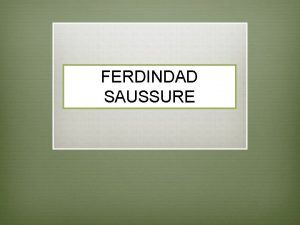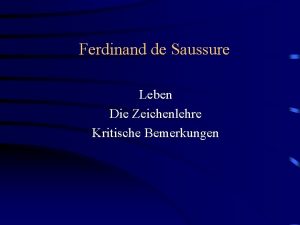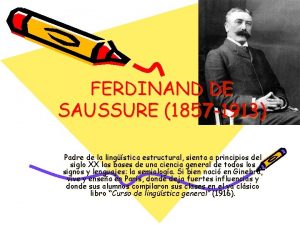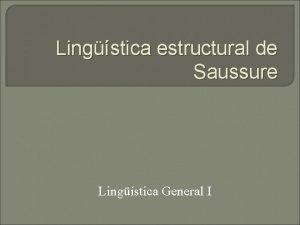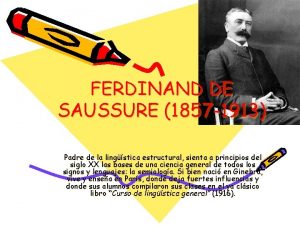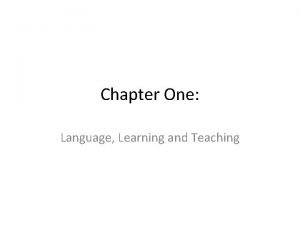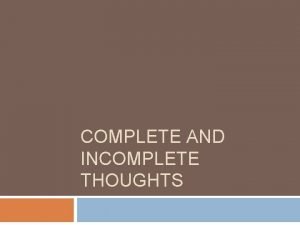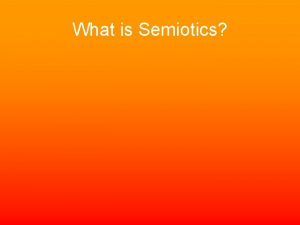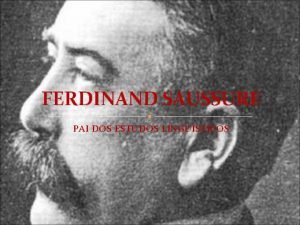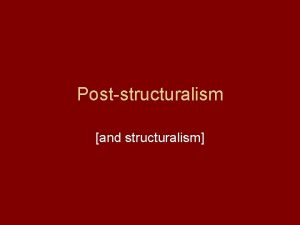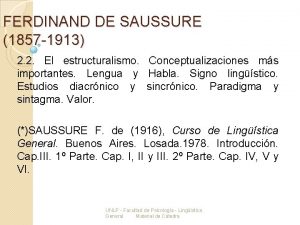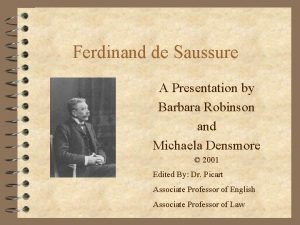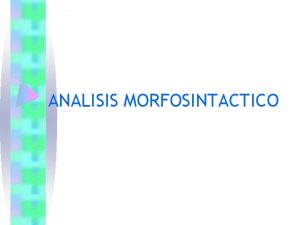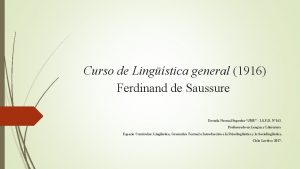FERDINAND DE SAUSSURE Structural Linguistics LANGUAGE THOUGHT v



![SIGNIFIER - SIGNIFIED v “The linguistic sign is arbitrary” (647) v “The term [arbitrary] SIGNIFIER - SIGNIFIED v “The linguistic sign is arbitrary” (647) v “The term [arbitrary]](https://slidetodoc.com/presentation_image_h/cfc2d58f109ab8d3ba60865e73a5490c/image-4.jpg)


![SIGNS & IDEAS WORK BY NEGATION v “[Concepts] are purely differential and defined not SIGNS & IDEAS WORK BY NEGATION v “[Concepts] are purely differential and defined not](https://slidetodoc.com/presentation_image_h/cfc2d58f109ab8d3ba60865e73a5490c/image-7.jpg)



- Slides: 10

FERDINAND DE SAUSSURE Structural Linguistics

LANGUAGE / THOUGHT v COMMON SENSE SAYS: “that ready-made ideas exist before words” (646). v ACTUALLY: “Without language, thought is a vague, uncharted nebula. There are no pre-existing ideas, and nothing is distinct before the appearance of language” (649). v “Structural Linguistics” “THE LINGUISTIC TURN”

SEMIOTICS: STUDY OF THE LINGUISTIC SIGN
![SIGNIFIER SIGNIFIED v The linguistic sign is arbitrary 647 v The term arbitrary SIGNIFIER - SIGNIFIED v “The linguistic sign is arbitrary” (647) v “The term [arbitrary]](https://slidetodoc.com/presentation_image_h/cfc2d58f109ab8d3ba60865e73a5490c/image-4.jpg)
SIGNIFIER - SIGNIFIED v “The linguistic sign is arbitrary” (647) v “The term [arbitrary] should not imply that the choice of the signifier is left entirely to the speaker […]; I mean that it is unmotivated, i. e arbitrary in that it actually has no natural connection with the signified. ” (648)

VALUE & DIFFERENCE “Language is a system of interdependent terms in which the value of each term results solely from the simultaneous presence of others. ” (650). Value: the function of a sign within the system.

“Language can … be compared with a sheet of paper: thought is the front and the sound the back; one cannot cut the front without cutting the back at the same time; likewise in language, one can neither divide sound from thought nor thought from sound. ” (649)
![SIGNS IDEAS WORK BY NEGATION v Concepts are purely differential and defined not SIGNS & IDEAS WORK BY NEGATION v “[Concepts] are purely differential and defined not](https://slidetodoc.com/presentation_image_h/cfc2d58f109ab8d3ba60865e73a5490c/image-7.jpg)
SIGNS & IDEAS WORK BY NEGATION v “[Concepts] are purely differential and defined not by their positive content but negatively by their relations with the other terms of the system. Their more precise characteristic is in being what the others are not” (651). v KEYS: Signs are both ARBITRARY and DIFFERENTIAL, i. e. based on a function in a system.

SOCIAL FORM / STRUCTURE v “The arbitrary nature of the sign explains…why the social fact alone can create a linguistic system. The community is necessary […]; by himself the individual is incapable of fixing a single value” (649). v The sheet of paper (649).

F. BOAZ, HANDBOOK OF AMERICAN INDIAN LANGUAGES, 1911 v To take again the example of English, we find that the idea of WATER is expressed in a great variety of forms: one term serves to express water as a LIQUID; another one, water in the form of a large expanse (LAKE); others, water as running in a large body or in a small body (RIVER and BROOK); still other terms express water in the form of RAIN, DEW, WAVE, and FOAM. It is perfectly conceivable that this variety of ideas, each of which is expressed by a single independent term in English, might be expressed in other languages by derivations from the same term. Another example of the same kind, the words for SNOW in Eskimo, may be given. Here we find one word, aput, expressing SNOW ON THE GROUND; another one, qana, FALLING SNOW; a third one, piqsirpoq, DRIFTING SNOW; and a fourth one, qimuqsuq, A SNOWDRIFT. (25 -26).

“MOCK TURTLE”
 Aportes de ferdinand de saussure a la linguistica
Aportes de ferdinand de saussure a la linguistica Ferdinand de saussure sprachtheorie
Ferdinand de saussure sprachtheorie Padre de la linguistica estructural
Padre de la linguistica estructural Aporte de ferdinand de saussure
Aporte de ferdinand de saussure Padre de la lingüística
Padre de la lingüística Language
Language Applied linguistics
Applied linguistics Structural linguistic and behavioral psychology
Structural linguistic and behavioral psychology Complete and incomplete thoughts
Complete and incomplete thoughts Peirce semiotics
Peirce semiotics Structuralist
Structuralist
